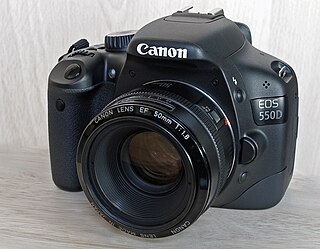
Digital video is an electronic representation of moving visual images (video) in the form of encoded digital data. This is in contrast to analog video, which represents moving visual images in the form of analog signals. Digital video comprises a series of digital images displayed in rapid succession, usually at 24 frames per second. Digital video has many advantages such as easy copying, multicasting, sharing and storage.

Video is an electronic medium for the recording, copying, playback, broadcasting, and display of moving visual media. Video was first developed for mechanical television systems, which were quickly replaced by cathode-ray tube (CRT) systems which, in turn, were replaced by flat panel displays of several types.

DV refers to a family of codecs and tape formats used for storing digital video, launched in 1995 by a consortium of video camera manufacturers led by Sony and Panasonic. In the late 1990s and early 2000s, DV was strongly associated with the transition from analog to digital desktop video production, and also with several enduring "prosumer" camera designs such as the Sony VX-1000. DV is sometimes referred to as MiniDV, which was the most popular tape format using a DV codec during this time.
A video codec is software or hardware that compresses and decompresses digital video. In the context of video compression, codec is a portmanteau of encoder and decoder, while a device that only compresses is typically called an encoder, and one that only decompresses is a decoder.

Chroma subsampling is the practice of encoding images by implementing less resolution for chroma information than for luma information, taking advantage of the human visual system's lower acuity for color differences than for luminance.

Component video is an analog video signal that has been split into two or more component channels. In popular use, it refers to a type of component analog video (CAV) information that is transmitted or stored as three separate signals. Component video can be contrasted with composite video in which all the video information is combined into a single signal that is used in analog television. Unlike composite, component cables do not carry audio and are often paired with audio cables.

A camcorder is a self-contained portable electronic device with video and recording as its primary function. It is typically equipped with an articulating screen mounted on the left side, a belt to facilitate holding on the right side, hot-swappable battery facing towards the user, hot-swappable recording media, and an internally contained quiet optical zoom lens.
A digital video recorder (DVR) is an electronic device that records video in a digital format to a disk drive, USB flash drive, SD memory card, SSD or other local or networked mass storage device. The term includes set-top boxes with direct to disk recording, portable media players and TV gateways with recording capability, and digital camcorders. Personal computers are often connected to video capture devices and used as DVRs; in such cases the application software used to record video is an integral part of the DVR. Many DVRs are classified as consumer electronic devices; such devices may alternatively be referred to as personal video recorders (PVRs), particularly in Canada. Similar small devices with built-in displays and SSD support may be used for professional film or video production, as these recorders often do not have the limitations that built-in recorders in cameras have, offering wider codec support, the removal of recording time limitations and higher bitrates.

High-Definition Multimedia Interface (HDMI) is a proprietary audio/video interface for transmitting uncompressed video data and compressed or uncompressed digital audio data from an HDMI-compliant source device, such as a display controller, to a compatible computer monitor, video projector, digital television, or digital audio device. HDMI is a digital replacement for analog video standards.

HDV is a format for recording of high-definition video on DV videocassette tape. The format was originally developed by JVC and supported by Sony, Canon, and Sharp. The four companies formed the HDV Consortium in September 2003.

DisplayPort (DP) is a digital display interface developed by a consortium of PC and chip manufacturers and standardized by the Video Electronics Standards Association (VESA). It is primarily used to connect a video source to a display device such as a computer monitor. It can also carry audio, USB, and other forms of data.
In video, luma represents the brightness in an image. Luma is typically paired with chrominance. Luma represents the achromatic image, while the chroma components represent the color information. Converting R′G′B′ sources into luma and chroma allows for chroma subsampling: because human vision has finer spatial sensitivity to luminance differences than chromatic differences, video systems can store and transmit chromatic information at lower resolution, optimizing perceived detail at a particular bandwidth.

The Canon EOS 5D Mark II is a 21.0 effective megapixel full-frame CMOS digital single-lens reflex camera made by Canon, the first Canon EOS camera to have video recording capabilities. It succeeds the EOS 5D and was announced on 17 September 2008.
Uncompressed video is digital video that either has never been compressed or was generated by decompressing previously compressed digital video. It is commonly used by video cameras, video monitors, video recording devices, and in video processors that perform functions such as image resizing, image rotation, deinterlacing, and text and graphics overlay. It is conveyed over various types of baseband digital video interfaces, such as HDMI, DVI, DisplayPort and SDI. Standards also exist for the carriage of uncompressed video over computer networks.

The Canon EOS 550D is an 18.0 megapixel digital single-lens reflex camera, announced by Canon on 8 February 2010. It was available since 24 February 2010 and to US dealers from early March. It is known as the EOS Kiss X4 in Japan, and as the EOS Rebel T2i in the Americas. It is part of Canon's entry/mid-level digital SLR camera series, and was the successor model to the EOS 500D. It was succeeded by the EOS 600D, but remained in Canon's lineup until being discontinued in June 2012 with the announcement of the EOS 650D.
Apple ProRes is a high quality, "visually lossless" lossy video compression format developed by Apple Inc. for use in post-production that supports video resolution up to 8K. It is the successor of the Apple Intermediate Codec and was introduced in 2007 with Final Cut Studio 2. Much like the H.26x and MPEG standards, the ProRes family of codecs use compression algorithms based on the discrete cosine transform (DCT). ProRes is widely used as a final format delivery method for HD broadcast files in commercials, features, Blu-ray and streaming.

The Panasonic Lumix DMC-GH4 is a Micro Four Thirds System digital still and video camera originally released in May 2014. At the time of its release, the GH4 was notable for being the world's first Mirrorless interchangeable-lens camera with 4K Video recording capability.

The Canon EOS 7D Mark II is a professional digital single-lens reflex camera made by Canon. It was announced on September 15, 2014 with a suggested retail price of US$1,799. It features a 20.2 effective megapixel APS-C CMOS sensor, Full HD video recording at 60 fps, 10.0 frames per second continuous shooting, a 100% accuracy viewfinder that offers 1× magnification. It also features a 65-point auto-focus system, a built-in Speedlite transmitter and a new 150k RGB pixels + IR metering sensor. It was preceded by the Canon EOS 7D.
A video management system, also known as video management software plus a video management server, is a component of a security camera system that in general:

The Panasonic Lumix DC-GH5 is a Micro Four Thirds mirrorless interchangeable lens camera body announced by Panasonic on 4 January 2017.














